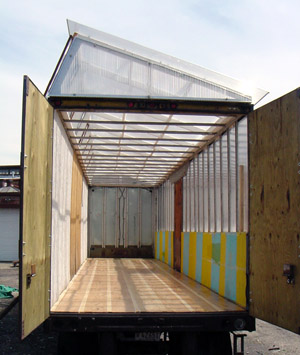Urban Agricultural Unit
| The Urban Agricultural Unit is a mobile greenhouse designed for educational, artistic, and commercial purposes. Constructed from a discarded shipping container, the structure’s innovative design is an example of the adaptive reuse of materials within the constraints of an urban setting. |
 |
 |
 |
 |
 |
 |
 |
 |
 |
 |
 |
 |
 |
 |
 |
 |
Design:
| The project’s intent has been to create a “living sculpture” through the transformation of a discarded shipping trailer into a greenhouse capable of year round production within an urban industrial environment. The Urban Agricultural Unit will be educational because it is functional. The project’s participants, comprised of volunteers and students, will share their knowledge and skills in order to improve the viability of urban agriculture on a larger scale. The project is also intended to foster community wide understanding of the advantages and necessity of thinking “out of the box” with respect to urban development. Coupling industrial waste with advanced agricultural technology, the UAU project is devoted to discovering how to do more… with less. |
Construction of the greenhouse:
The most important motivation in the design of the greenhouse was to make the most use of what already exists. Thus, the design retained the trailer’s original structural skeleton in order to enable the installation of a new transparent skin. The result is an adaptive reuse of the original container, retaining its essential form yet giving it new life and functionality. To this end, the south wall and pitched roof were recreated with twin wall polycarbonate panels. This relatively new material possesses excellent insulation properties while allowing for 80% light transmission. Many of the panels were also fitted with hinged frames to assist with summer ventilation. The aluminum removed from the south wall and the roof was reused to create a double wall which was then filled with insulation. The floor and doors were re-fabricated to fit their original designs. The end walls will also be fitted with exhaust fans to enable sufficient ventilation. |

Issues, Influences, and Solutions in Urbanism and Ecology:
The urbanization of the planet has created a growing concern for natural ecologies. Exponential growth in population and consumption has greatly increased the demands on natural resources, straining the stability of economies and ecosystems. Urban overcrowding has become common place all over the world as cities continue to grow in an unsustainable manner. Therefore, the issues of ecology and sustainability should become further integrated into efforts towards urban community planning and development. Technological advance has provided society with many of the tools and strategies it needs to pursue development with an increased degree of environmental efficiency and sensitivity. Yet the question remains as to why so few of these strategies have been implemented. The answer lies within the issue of community awareness. Such awareness can be encouraged through projects that exemplify viable alternatives to unsustainable development. These programs should be pursued in a local, participatory manner that also take global implications into account. The Urban Agricultural Unit is just one of a multitude of ways that urban space can be used in a productive manner that is not only beneficial to its surrounding community, but also inflicts minimal environmental impact. |

Why Hydroponics:
Within the past decade hydroponics has been slowly gaining acceptance as a viable agricultural alternative to soil production. However, very little effort has been focused on implementing this technology in the urban landscape, an application for which hydroponics is aptly suited. Contamination, biological imbalances, and the depletion of nutrients have made the soil in many urban settings unsuitable for agriculture. Furthermore, it stands to reason that exponential population growth and increasing transportation costs will continue to make the proposition of producing food within population centers more enticing. Efforts to this end are currently being undertaken in many Southeast Asian cities where urban overcrowding is felt more acutely. Today’s modern cities possess acres upon acres of unused roof space that could easily be used for more productive purposes. It is imperative that communities in the United States are aware of viable possibilities as urban planning and development projects move forward into the 21st century. |






